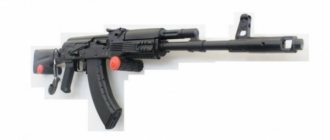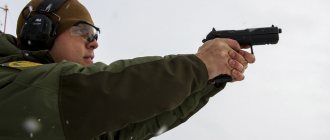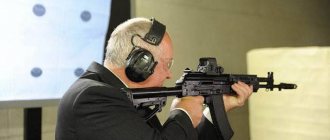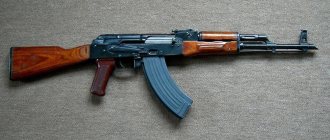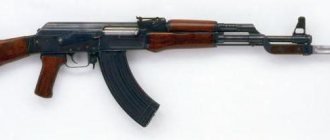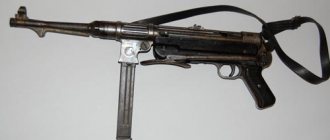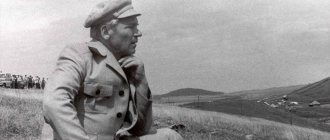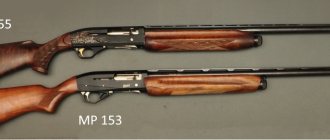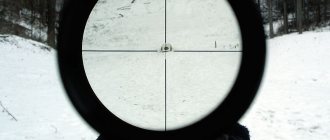AK or AR15? Echoes of disputes about military weapons are reaching the civilian market, especially since a significant part of civilian models are clones of military rifles. Until recently, it was believed that the Kalashnikov Arke was not a competitor at the shooting range. However, the revolution in the tuning market that has occurred in the last couple of years may radically change the situation. Lenta.ru continues to explore the capabilities of the AK platform.
Before the introduction of sanctions, civilian Kalashnikov clones had to compete to one degree or another with a good half of the NATO arsenal. AR15 rifles and their clones, including Russian and Ukrainian assembly, German NK416 and NK SL8 (civilian version of the G36 assault rifle), Austrian Steyr AUG; infrequently, but civilian versions of the Swiss SIG550 were found on sale. Plus a large number of purely hunting weapons of foreign brands. Now the market has shrunk, prices for the remaining imported weapons have skyrocketed. The already popular AK and RPK based carbines almost completely dominate the market.
Demobilized Kalashnikov
Today we have two civilian carbines based on the Kalashnikov, and the Vyatsko-Polyansky Machine-Building Plant (in the past produced Kalashnikov light machine guns (RPK)). The first produces Saiga hunting carbines based on the AK74 and AK 100 series, the second produces Vepr carbines based on the RPK. The design of the weapon presented on the Kalashnikov website is as similar as possible to the design of army prototypes. Calibers 5.45x39, 7.62x39, .223Rem, .308Win.
“Molot” experimented more with the exterior of civilian models - for example, a machine-gun receiver and barrel can be placed in classic wooden rifle stocks (“Vepr-Super”, “Vepr-Hunter”). In some hunting models, the fastening of the gas tube, the design of the trigger and sighting devices have been changed. Rifle calibers of 7.62x54 millimeters and the American .30-06 are also used. Of course, Molot also produces carbines in a “military” design (pistol grip, folding metal stock, plastic forend and gas tube cover), and the company’s arsenal also includes fenced versions of the RPK and AKM - VPO-134 and Vepr-KM, respectively "
Civilian versions of the AK have inherited all the advantages and disadvantages of their military ancestor: Saiga and Vepri have a reputation as very reliable, but not the most accurate weapons. Hunters also complain about the heavy weight of the Veprs - this makes it difficult to use carbines for running hunts. Nevertheless, among hunters there is a stable circle of fans of the AK platform who are ready to forgive shortcomings for the availability and high reliability of the weapon (it is believed that the latter factor is especially important in the northern regions).
Photo: Irina Mareeva Facebook page
But hunters are conservative and rarely engage in serious tuning of carbines. As a rule, they use weapons “out of the box,” that is, in their original configuration. But adherents of practical shooting and representatives of the weapons community that has formed around this discipline - “self-defenseists”, “survivalists” and simply military weapon lovers - are more often concerned with improving serial models.
In this sense, the Russian civilian rifle market is not much different from the American one. Weapons companies are aimed at mass production of standard models, and improving their characteristics is the task of special custom studios. In the Russian case, the role of the studio is played by the owner of the weapon and the tuning manufacturers.
Naked economy
It has long been believed among practical shooters that the competitiveness of the AK platform in comparison with the AR15 is low - the weapon is thrown quite strongly, which reduces the rate of fire, and accuracy is low compared to AR systems. The Federation of Practical Shooting of Russia even introduced experimental classes in the carbine discipline - “Kalashnikov Standard” and “Kalashnikov Open”. “Obviously, this was done in order to support the domestic carbine, since shooters with AK systems could not compete with top athletes who are massively armed with AR15 rifles,” explained the master of sports in practical shooting and co-chairman of the Molot club to Lente.ru Open Alexander Shorvaev.
According to him, the AR15 is now recognized as the world's best platform for a practical carbine. This is largely due to the abundance of tuning and the so-called open architecture of the rifle, which allows you to make all kinds of changes, make a suspended barrel, install sighting systems, etc.
Master of Sports Sergei Orlov with the Vepr VPO-125 carbine of .223 Rem caliber
Video: RED Molot Masters / YouTube
But most Russian athletes shoot from various versions of civilian AKs. These are mostly beginner and intermediate/upper-intermediate shooters. The choice of domestic weapons is determined, among other things, by their availability: “Saiga” and “Vepri” cost approximately from 25 thousand to 38 thousand rubles. Carbines based on AR15 are rare and their price is 150-250 thousand, and the cost of a rifle tuned “for sport” reaches 500 thousand rubles. At the same time, the barrel life of AR carbines, according to Shorvaev, is half that of the same “Vepr” - 10 thousand shots versus 20 thousand (with .223 Rem cartridges). The AR platform provides for barrel replacement, but a new barrel costs about 60 thousand rubles, that is, approximately twice as expensive as a new Saiga or Vepr.
By the way, if you use more “forgiving” 7.62x39 cartridges, the survivability of the same “Boars” will become even greater. “I know people whose 7.62x39 barrels have withstood more than 30 thousand shots and at the same time meet the army requirements for accuracy,” noted Lenta.ru’s interlocutor.
Baikal rifled hunting carbines
For many years, hunting smoothbore weapons have traditionally been sold under the Baikal brand. During the Soviet years, a variety of sporting weapons and equipment were exported under this brand. Today, the main models of Kalashnikov hunting weapons, including rifled hunting carbines, are produced under the Baikal brand.
Baikal 141 Sobol: small-caliber hunting carbine based on a biathlon rifle
Caliber: 5.6 (.22 LR) Magazine, rounds: 5 Barrel length, mm: 500 Weight, kg: 3.5
The history of the Sobol hunting carbine, created on the basis of the Bi-7-2 sports rifle, begins in 1986. Serial production of the carbine started in 1993. The modern version of this small-caliber rifle is the Baikal 141 Sobol carbine.
Inherited from its sports ancestor - the biathlon rifle - this carbine has retained its proprietary reloading system, which provides very fast and convenient manual reloading. The stock of the gun is made of walnut wood, equipped with the bases of quick-release swivels of the Uncle Mike's type, which ensure reliable and convenient fastening of the belt to the carbine.
Open sights have rear sights at 25 and 75 meters; the receiver has a Picatinny rail for mounting optical sights. The price of the Baikal 141 Sable carbine in the Kalashnikov Market online store starts from 31,490 rubles.
Baikal 145 Los: classic hunting rifle with manual reloading
Caliber: .223 Rem; .308 Win Magazine, cartridges: 3 Barrel length, mm: 550 Weight, kg: 3.4
In 1964, production of Elk hunting carbines chambered for 9×53R began in Izhevsk. In 1977, it was replaced by the new Los-4 carbine, created for the domestic 7.62×51A cartridge, externally identical to the .308 Winchester cartridge, but differing from it in ballistic characteristics. Later, the 7.62×51M cartridge appeared, completely identical to its foreign counterpart. Moose adapted to the new cartridge and in 1985 changed the index to Los-7. After another nine years, the Los-7-1 modification came into production with a more convenient fuse and a detachable magazine instead of a non-removable one.
A fundamental update of the “Moose” took place already in the new century - in 2018, a modern hunting carbine with manual reloading, the Baikal 145 Los, came into production. This carbine is available in two versions: with a short (chambered .223 Remington) or standard (chambered .308 Winchester) receiver and bolt. All Baikal 145 carbines have barrels with a chrome-plated bore and chamber, freely hung in a durable wooden stock, as well as a Picatinny rail built into the receiver for mounting optical sights.
How to treat Kalashnikov “sores”
Practicing shooters are rarely satisfied with carbines “out of the box”, trying to customize the weapon for themselves. Owners of civilian AKs are faced with several standard tasks: improving the ergonomics of the weapon, minimizing barrel bounce after firing as much as possible, making the descent more comfortable, and also solving the issue of reliable mounting of optical and/or collimator sights. It would also be a good idea to hang the barrel, which affects the accuracy and accuracy of shooting.
The easiest way to solve the first problem is that many companies, domestic and foreign, offer components to improve ergonomics: handles, adjustable stocks, elongated forends (they are preferred by competitive shooters), safety catches with special protrusions that allow you to manipulate it without taking the shooting hand off the control handle fire, etc. According to Lenta.ru estimates, making such changes costs from 15 to 40 thousand rubles.
Photo: Tatyana Korobeinik
The situation is more difficult with overcoming the throwing of weapons; effective solutions for this have been proposed relatively recently - these are new DTKs, lightweight bolt carriers, titanium gas pistons, as well as adjustable gas units.
“To prepare the Saiga for competitions, athletes install lightweight bolt frames in their carbines and regulate their recoil speed with the length of a special piston,” says Honored Master of Sports Vsevolod Ilyin. — This allows us to achieve almost shock-free operation of the automation. Effective shooting also requires the installation of a sports trigger mechanism with a short trigger stroke and less trigger force.”
These operations will cost another 20-25 thousand rubles. But the results of such tuning are impressive: rapid fire (several shots per second) with virtually no barrel toss. Moreover, this result is shown not only by shooters with weapons chambered for a low-pulse cartridge - .223Rem, 5.45x39, but also by owners of weapons based on AKM 7.62x39 caliber.
Civilian versions of Kalashnikov assault rifles
The legendary Kalashnikov assault rifle became the basis for various types of civilian weapons. One of the latest innovations for the civilian market is the TG2 carbine, developed on the basis of the AK103, and the TR3 carbine, an almost complete analogue of the latest AK-12 and AK-15 assault rifles.
TG2 smoothbore carbine: ballistics of rifled weapons under a smoothbore license
Caliber: 9.55 Magazine, cartridges: 10 Length, mm: 945 Weight, kg: 3.6 Magazine 1 Barrel length, mm 415
The TG2 smoothbore carbine chambered for the .366 TKM cartridge is completely identical in appearance to the “hundredth series” Kalashnikov assault rifle – the AK-103 model. Just like its military counterpart, the TG2 received a butt folding on the left side and the ability to block fire when the butt was folded.
The key feature of this shotgun is the .366 TKM (9.5x38mm) cartridge used. As experts note, this cartridge is similar in ballistics to the 7.62x39 mm cartridge - it allows you to accurately hit the target at distances inaccessible to conventional smooth-bore weapons. Kalashnikov representatives are confident that at a distance of 100 meters the ballistics of this cartridge are the same as those of a rifled weapon. Thus, the .366 TKM cartridge allows the TG2 carbine to be used for hunting animals weighing up to 200 kg at a distance of up to 200 meters, as well as for target practice and self-defense. For example, it is believed that with this cartridge you can hit a tall figure at a distance of up to 200 meters.
Today the price of the TG2 smoothbore carbine is about 40 thousand rubles. You can also find on sale the TG2 anniversary series, made in the classic style of the legendary Kalashnikov assault rifle, at a price of 91,590 rubles.
TR3 hunting carbines: developed on the basis of the AK-12 and AK-15 and are completely similar to them
Caliber: 5.45; 7.62; 9.55 Magazine, cartridges: 10 Length, mm: 880/940 Weight, kg: 3.8 Magazine 1 Barrel length, mm 415
Last year, at a presentation on the eve of the Army forum, the Kalashnikov Concern officially presented the civilian version of the latest AK-12 and AK-15 assault rifles - the TR3 carbine in calibers 5.45x39 and 7.62x39.
TR3 carbines have the same dimensions as their “combat” relatives and are equipped with folding butts that are adjustable in length. The TR3 handle contains a special case with accessories for cleaning and lubricating the weapon. There is a Picatinny rail on the receiver cover, which makes it possible to conveniently install day and night sights of various types. Additional accessories can be mounted on the Picatinny rail on the bottom of the handguard. Experienced shooters note the fact that the TR3 trigger mechanism, like that of the AK-12 and AK-15 assault rifles, has three axes - this solves the problem of firing when the bolt is not fully closed.
While completely similar to its “combat” comrades, the TR3 is, of course, different from the AK-12 and AK-15. First of all, this is the standard lack of ability to fire in bursts. However, the capacity of the magazines supplied with the carbine is limited to 10 rounds.
Most recently, the Concern introduced the TR3 chambered for the .366 TKM hunting cartridge. This carbine is certified as a smoothbore weapon. The price for TR3 carbines chambered for 5.45×39 and 7.62×39 is from 62,100 rubles, and for the .366 TKM cartridge – from 69 thousand rubles.
Sight of Discord
Perhaps the biggest controversy is around the problem of installing additional sights on the AK platform. This is perhaps her main “sore”. There are three most common solutions: a bracket with a Picatinny rail, which is mounted on the side rail on the receiver; hinged receiver covers with integrated Weaver/Picatinny rails; strips installed with screws instead of a standard rear sight (sold under the “Nomad” brand).
“The disadvantage of the first method is the bulkiness of the design and often a “breathing” strap riveted to the receiver,” Sergei Orlov, master of sports and co-chairman of Molot Open, comments on the proposed options. — Domestic brackets, as a rule, are too high, which requires the installation of an additional cheek piece on the butt, and heavy. High-quality imported ones are very expensive, and their advantages can be negated by poor-quality fastening of the side bar.”
Master of Sports Alexander Shorvaev demonstrates the Vepr-KM 7.62x39 caliber with an adjustable gas block
Video: Alexander Shorvaev / YouTube
As for hinged lids, according to Orlov, “despite all the manufacturers’ statements, they keep zero very conditionally.” “At distances of 50-100 meters this may be enough, but at 300 meters I would prefer something more stable,” the athlete added. Perhaps the most effective option today is the installation of a “Nomad” type bar - with proper execution, it is possible to minimize vibrations. With reliable fastening of the bar and installation of high-quality optics, the serial “Vepr-V1 VPO125” from 100 meters allows you to place bullets in a circle with a diameter of 4.5-6 centimeters, representatives of Molot Open said. The last task, according to experts, is to hang the barrel without major design changes, after which the tuned Vepr will become a full-fledged competitor to the AR system. Molot Open promises to present its version in the near future; as Alexander Shorvaev assured, all the parts for building such a device are freely available on the Russian market.
